338 BC -- The beginning: Conquest of the LatinLeague.
279 BC -- Minimum: Losses to Pyrrhus.
212 BC --Minimum: Hannibal's Campaigns.
86 BC -- Minimum: Losses to Mithridates.
9 AD -- Maximum: Augustus' Conquest of Germany.
116 -- Maximum: Trajan's Victory over theParthians.
269 -- Minimum: Secession of the Gallic Empire andPalmyra.
336 -- Maximum: Reunification under Constantine.
485 -- Minimum: Loss of the West to Germanic Kingdoms.
565 -- Maximum: Justinian's reconquest of the West.
623 -- Minimum: Losses to Avars and Persia.
754 -- Minimum: Losses to Arabs and Lombards.
812 -- Maximum: The Reborn Western Empire of Charlemagne.
925 -- Minimum: End of Western Empire, Losses toBulgars and Arabs.
1040 -- Maximum: Revival of the West, Revancheof the East.
1181 -- Maximum: Expansion into Poland.
1288 -- Maximum: Reunification of the East.
1403 -- Maximum: Respite from the Turks.
1452 -- The End: Conquest by the Turks.
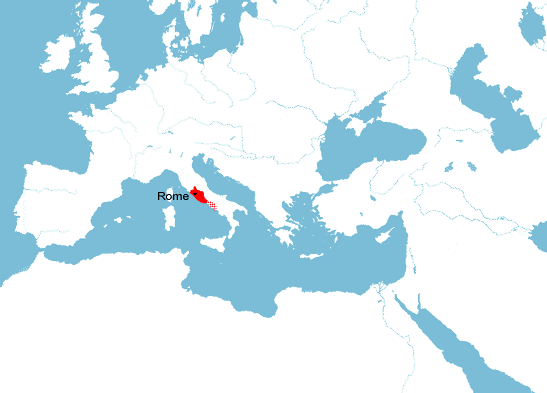
In 510 BC, the city of Rome overthrew its Etruscan rulers (to the North-West)and became a republic. It rapidly grew in size and power, becoming theleading city in central Italy and supreme commander of the League of LatinCities in times of war. In 340 BC the Latin cities revolted, but Rome defeatedthem and they came under direct Roman rule in 338 BC. This area, thenascent Roman Empire, is indicated in redinthe above map. The stippled red area isCapua,an independent area owing allegiance to the Roman Empire. Theseconventions apply to all of the maps below also.
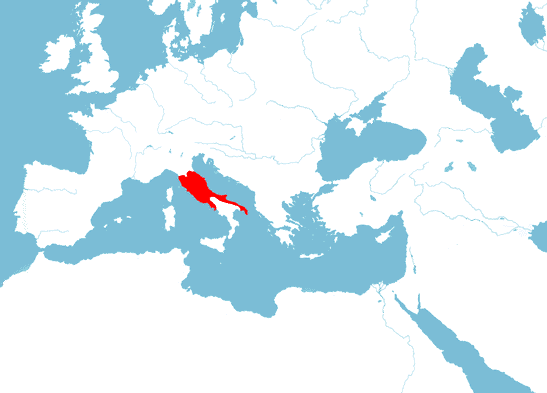
In 326-290 BC Rome won the struggle for control of Italy against itsmain rival, the Samnites to the south-east. The Samnite allies includedthe Etruscans, and the Gauls to the north-west. Almost the whole of centraland southern Italy came under Roman rule. Under threat, the Greek citieson the "sole" of Italy called in Pyrrhus, Greek king of Epirus (acrossthe Adriatic from the "heel" of Italy). He beat the Roman legions and drovethem out of most of southern Italy in 279 BC. However the lossesto his own forces were enormous, whence the phrase a "Pyrrhic victory".Pyrrhus went on to conquer Sicily from the Carthaginians, who were alliedto Rome in this war.

The Romans finally got the better of Pyrrhus in 275 BC, and by 272 BChad secured the entirety of southern Italy. The next target of Rome's aggressionwas the great maritime Empire of Carthage. The first Punic war (so calledbecause Carthage was originally a Punic, i.e. Phoenician, colony) of 264-241BC ended in a Carthaginian defeat. The western Mediterranean islands ofSicily, Sardinia and Corsica were ceded to Rome. Rome acquired territoriesacross the Adriatic in anti-piracy campaigns in the the 220s, and at thesame time conquered the Celts in northern Italy. Meanwhile, Carthage hadrebuilt its position by conquering much of Spain, and it was here thatthe second Punic war began in 218. This time it was a war for survival.The great Carthaginian general Hannibal defeated the Romans in Spain andinvaded Italy over the Alps. There he inflicted defeat after defeat onthe Roman legions, the worst being at Cannae in 216 where the Romans lostsome 50 000 troops. As during the invasion of Pyrrhus, the Samnites defected,and so did the Greek South in 212.
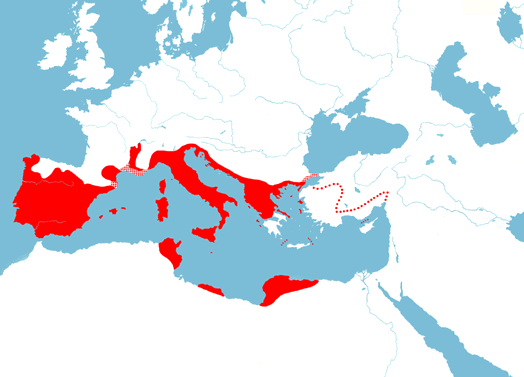
Despite his victories, Hannibal was unable to capture Rome itself, andthe Roman legions finally secured a victory against him in 211. ElsewhereRoman forces were also gaining the upper hand. In 203 Hannibal evacuatedItaly, to defend Carthage against a Roman attack. There he was defeatedby the Roman general Scipio in 202, and the war was concluded with harshterms imposed upon Carthage. Rome acquired the whole eastern coast of Spain,and went on to conquer most of the country by 133 BC. As usual, Rome wasat war most of the time, and everywhere its legions were eventually successful.Macedonia was annexed in 148 BC, Greece and Carthage two years later. Bythis time, the city of Rome had reached the 100 000 mark and its only rivalswere Antioch, capital of the rapidly shrinking Selucid Kingdom, and Alexandria,capital of the Ptolemaic Kingdom of Egypt. Such was Rome's prestige thatthe king of Pergamum in western Anatolia bowed to the inevitable and in133 BC bequeathed his kingdom to Rome. Other kingdoms in Anatolia put themselvesunder Roman protection. Only one kingdom dared challenge Roman supremacy:Pontus, on the southern shore of the Black Sea. From 110-100 BC, King Mithridates(120-66 BC) more than quadrupled its territory, expanding eastward, southward(conquering the Roman protectorates in central Anatolia), and northward(conquering the Bosporan Kingdom on the northern shore of the Black Sea).In 88 BC, as Italy was just emerging from the "Social War" (which compelledRome to extend the citizenship to all of Italy), Mithradates struck westward.The Roman province of Asia was over-run and 60 000 Romans executed. In86 BC southern Greece defected to Mithradates, and received a Pontic army.Rome's strategic position in the East seemed to be falling apart.

Rome's efforts to put Mithradates back in his place were hampered bycivil strife at home between the populists lead by Marius and the aristocratslead by Sulla. However, the latter defeated Mithradates in 85 BC, and theEastern frontier was restored by 81 BC. But Mithradates had not given up,and Sulla's successor Pompey was sent East again. By 66 BC, the Roman victorywas complete: Mithradates committed suicide, the coast from Pontus to Syria(inclusive) was annexed to Rome, and the interior reduced to vassalage.In the West, Pompey's rival Julius Caesar (nephew of Marius) made evenmore spectacular gains during his military appointment, conquering allof Gaul by 51 BC and even raiding Britain. By this time the republicansystem was clearly breaking down as rival generals sought absolute power,or a share in it. The civil wars of 49-30 BC ended with this absolute powerin the hands of Octavian, nephew and heir of Caesar. In 27 BC the Senatebestowed upon him the honorary title Augustus. As the first Emperor ofRome he was careful nevertheless to maintain the institutions of the Republic,and the fiction of their role in government. Legally, he was merely thePrinceps,the first citizen, and so this system is called the Principate.No mere politician, Octavian finished the job begun by his predecessorsby annexing or reducing to vassalage all of the land south of the Danubeand Rhine, East of the Euphrates, and North of the Sahara. His most ambitiousproject was to conquer Germany, which seemed well in hand by 9 AD.
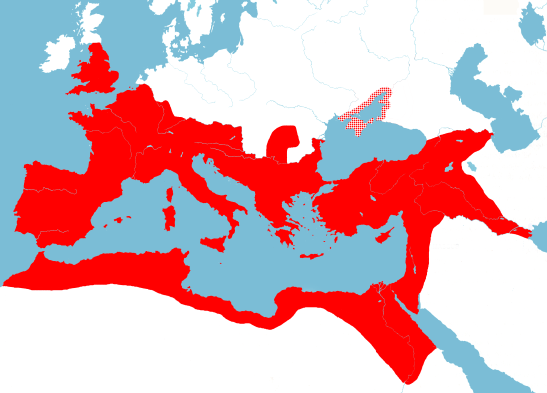
Germany proved more trouble than it was worth when three legions (about15 000 men) were ambushed and annihilated in the Tutoburger forest in 9AD. The frontier was pulled back to the Rhine, but elsewhere modest expansioncontinued under the Julio-Claudian dynasty. Most notably, most of Britainwas conquered (43-80). In 68, the deeply unpopular Nero, last of the Julio-Claudians,committed suicide. Out of the ensuing civil war the commander of the easternarmies, Flavian, emerged victorious. The end of his short-lived dynastyin 96 was followed by almost a century of stable and capable rule by theadoptiveEmperors, so called because each adopted his most promising subordinateas his successor. This was the time Gibbon called "the period in the historyof the world during which the condition of the human race was most happyand prosperous". The population of Rome reflected this, reaching perhaps500 000, the largest in the world. For the most part the adoptive Emperorswere content to maintain the territorial limits of the Empire, but thenotable exception is Trajan (98-117). He conquered the troublesome Dacianson the north shore of the Danube (101-106), and in 114 went to war withthe Parthian Empire, Rome's rival to the east. He annexed Armenia in 114,northern Mesopotamia in 115, and occupied southern Mesopotamia all theway to the Persian gulf in 116.
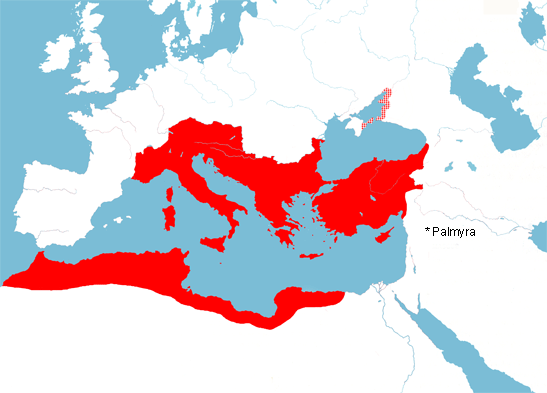
Trajan's conquests in the east proved impossible to hold, and his successorHadrian (117-138) immediately pulled the frontier back to the Euphrates,although Armenia remained a client state. The following Pax Romanalasted until the murder of Commodus, the last adopted Emperor. The ensuingcivil war (193-97) was won by Severus, whose dynasty maintained stabilityuntil 235. However, for an Empire made rich on conquest and plunder,peace did not necessarily mean prosperity. The coinage was repeatedly debasedfrom about 170 onwards, and by the time of this map the silver contentwas only a few percent. In 212 all free men in the Empire were made citizens,an attempt to increase its tax base. With economic decline came politicalinstability: in the half century after 235, there were 15 Emperors, mostruling only a few years. At the same time, Rome's enemies had become morepowerful. In the east, the Parthians had been replaced in 226 by the SassanidPersians, who sought to restore the glory of the Persian Empire 700 yearsbefore. They sacked Antioch in 253 and took the Emperor Valerian prisonerat Edessa in 260. Simultaneously, Germans raided deep into the Empire,reaching the Mediterranean at several points. The Empire's impotence promptedregional commanders to seize control in the worst affected areas. In thewest, Postumus founded a Gallic Empire in 260, including Spain and Britain.In the east, the semi-independent trading city of Palmyra became the centrefor resistance. Its ruler, Odenathus beat back the Persians and even sackedtheir capital Ctephiston. On his death in 267, his more ambitious widow,Zenobia, took power, and had by 269 conquered Roman Syria, Palestine andEgypt.

Zenobia was defeated and captured in 272. In the west, Spain had returnedto the Empire by 270, Gaul and Britain by 275. Against the odds, the Empirehad survived, losing only peripheral territories, and even gaining againstthe Sassanids. Stable government was restored under Diocletian (284-305).Recognizing the need for regional-based commanders, he divided the Empirein two (East and West) each under an Augustus. The legal pretences of thePrincipate were dropped; citizens became subject of the Emperor, who wastheir lord (dominus, whence the form of government is termed theDominate).Diocletian also instituted a regular means for succession, the Tetrarchy,involving two more junior Emperors, the Caesars. This worked once only,on Diocletian's retirement. After that, predictably, the plethora of Emperorsand their disinherited sons led to civil war. The eventual victor and soleEmperor from 324 to 337 was Constantine the great. He is notable for twoincalculably important decisions. First, he converted to Christianity,and under his dynasty (which lasted until 363) it became the dominant religionof the Empire. Second, he founded New Rome, a Christian capital,on the site of Byzantium, in 330. A second Senate was created for Constantinople(as it soon became known), and each Senate now nominated one Consul eachyear. As it had been during the Republic (in which the two Consuls sharedthe executive power), their names were used to identify the year. UnlikeRome, Constantinople was also the seat of the Emperor when in the East;in the West, the Imperial court was in Milan, and from 405 in Ravenna.Thisnew situation, of an Empire with two capitals(Rome and Byzantium) is indicated by the changefrom red to purple inthe above map.
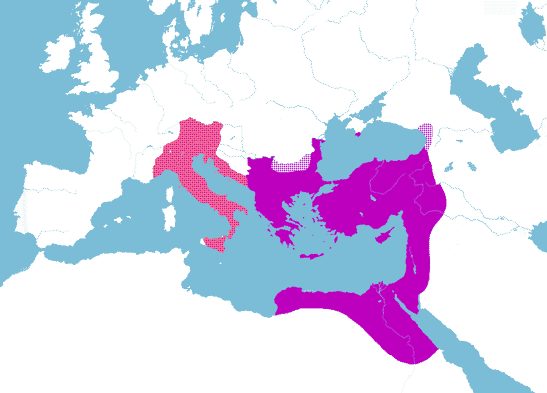
In 375, the Visigoths, fleeing the Huns who had invaded Europe fromcentral Asia, were allowed to settle south of the Danube. Poorly treated,they revolted in 378 and destroyed the Imperial army sent against them.With Roman subjects unwilling to serve in the army, the Empire took toreplacing them with German tribes, starting with the Visigoths themselves. In 395, Theodosius the great, the last Emperor of the East and West, died,dividing the Empire between his two sons. Taking advantage of the situation,the Visigoths revolted again in 395, invaded Italy and sacked Rome in 410.Meanwhile, Vandals and Sueves had invaded across the Rhine, and Britainhad rebelled. The Empire in the West maintained just enough strength torepel the Huns from Gaul in 451, with help from its German allies. Afterthat it went into terminal decline, and by 476 had almost no territoryoutside Italy. In that year the last Western Emperor, aptly named Romulus,was deposed and replaced by Odovacer, a German, who titled himself Kingof Italy. Odovacer claimed to govern in the name of Emperor Zeno in theEast. The East had always ben the richer half, and had survived theGermanic and Hunnic invasions almost unscathed. At first Zeno did not acceptthis offer, but in 480 he gave Odovacer the title of Patrician, and from483 he allowed the Senate in Rome to nominate one of the two Consuls, asit had done under the Emperors. This curious state of affairs around 485is indicated by the colours of the above map. Odovacer'skingdom is coloured pale red: although itwas in fact the successor to the Western Roman Empire, it did not claimto be such. But it is also stippled purplebecause it was nominally part of a united Empire.

Zeno was never really reconciled to Odovacer's position in Italy, andhad no qualms in encouraging the Ostrogoths (who from 476 to 488 occupiedthe stippled area south of the Danube in the 485 map) to Invade Italy in488. By 493, their king Theodoric had replaced Odovacer, and again claimedto rule in the name of the Emperor (now Anastasius I). Theodoric strengthenedand expanded his kingdom, and ruled as a Roman Emperor in all but name.Anastasius even returned the Imperial regalia (surrendered by Odovacerin 476) to Rome in 497. Theodoric died in 526 and the next year Justinianthe great came to the throne in Constantinople, with a mission to regainthe West for the Empire. From 533 to 540 his general Belisarius conqueredAfrica from the Vandals and most of Italy from the Ostrogoths. The latteroffered Belisarius their allegiance, and he could easily have declaredhimself Emperor of a reborn Western Empire. But he did not, the Ostrogothsrallied, and the ruinous war in Italy dragged on. When Ostrogothic resistanceceased in 562, the city of Rome was a shadow of its former self. Justinianhad already abolished the Senate there, and the office of Consul altogether.Although it held Rome, Justinian's Empirewas ruled entirely from Byzantium (Constantinople), hence its blue colouringin the above map. Constantinople was now as large as Rome in itsheyday, with a population of some 500 000, and again the largest city inthe world. Simultaneously with the final Italian campaign, Justinian sentImperial troops to help the pro-Roman Athanagild gain the throne of theVisigothic kingdom in Spain. He was successful, and in return acknowledgedImperial suzerainty, and ceded southern Spain to the Empire.
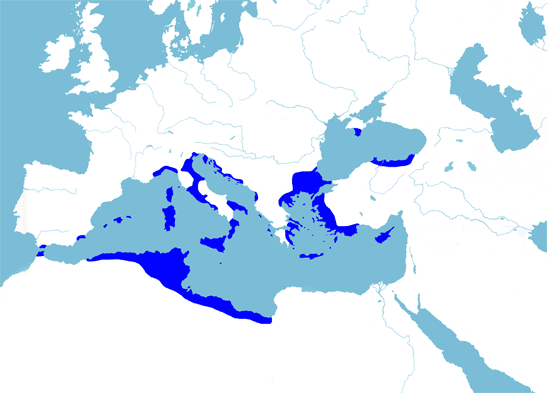
Justinian was barely cold in his grave (565) when his rebuilt Empirebegan to crumble. Fleeing the Avars (who played much the same role thatthe Huns had done almost 200 years earlier), the Lombards invaded Italyin 568. When a temporary equilibrium was reached by about 605, the Romanshad managed to keep almost half the country, and to prevent the formationof a unified Lombard kingdom. In 575 the Visigoths repudiated Roman suzerainty,and began the process of reducing the Imperial province in Spain, whichwas all but complete by 623. The Balkans were repeatedly raided by Avars,and Slav settlers immigrated in their wake. Finally, taking advantage ofa palace coup in Constantinople, the Sassanid King Chosroes II of Persiainvaded in 603, and had conquered Mesopotamia by 610. This prompted anothercoup in Constantinople, which saw Heraclius, the son of the governor ofAfrica, installed on the throne. But the Persians continued to advance,and by 620 had conquered Syria, Palestine, Egypt, Cilicia (south-east Anatolia)and Armenia. Most of the Balkans were occupied by the Avars. The Empireappeared so weak that the Sassanids now set their sights on nothing lessthan a complete conquest. Rather than wait for them, Heraclius appropriatedall the wealth of Constantinople (including that of the Church), paid offthe Avars, reorganized his army and in 624 set out for the East.
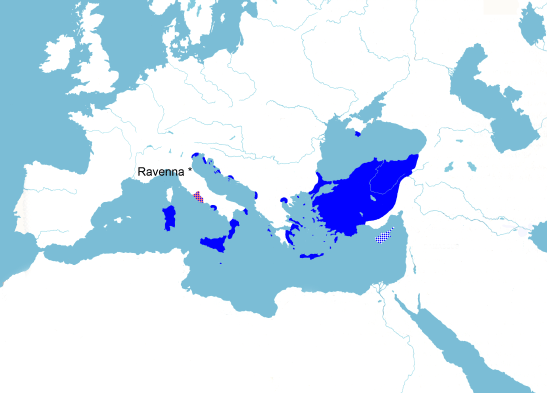
In a series of brilliant campaigns from 624 to 628, Heraclius ravagedthe heartlands of Persia. Putting his faith (justly) in the walls of Constantinople,the Imperial navy, and the Holy Virgin, he ignored a siege of his capitalin 626 by the Persians and perfidious Avars. With bravery bordering onrecklessness he lead his army to victory after victory. In 628 the Sassanidaristocracy overthrew Chosroes and opened negotiations for peace. By 630the Imperial frontier in the East had been fully restored. It seems a pitythat Heraclius did not die immediately following his Triumph in 631, rather than live, as he did, for another 10 years, and see the Arabsconquer all the lands he had just recovered. Filled with the new faithof Mohammed, they burst forth from Arabia in 634 and overwhelmed the exhaustedarmies of the Roman and Persian Empires. Nevertheless, Heraclius is rememberedas one of the great soldier-Emperors, the founder of a dynasty that lasted100 years, the last Emperor to come to the throne from the Latin West,but the first to adopt the Greek title Basileus (rather than Imperator).His provincial home, Carthage, was the last Roman territory in Africa tofall to the Arabs, in 698. Every year they raided deep into Anatolia, andthey besieged Constantinople in 674-8 and again in 717-8. Meanwhile inItaly the Lombards were, little by little, acquiring the Empire's territory.In 751 they finally captured the Imperial headquarters, Ravenna. Rome wasclearly next, with no hope of reinforcements from Byzantium. Pope Zachary(who had been de facto ruler of Rome since 741) took the extraordinarystep of seeking help instead from the Frankish kingdom. In 751 he approvedPepin's elevation from Major-Domo (a position which had been thereal power behind the throne for a century) to King of the Franks. Pepinobliged in 754 by clearing the Lombards out of the Papal state, which howevernominally remained part of the Byzantine Empire. Because of its ambiguousstatus it is coloured pale red with bluestipling, similarly to Odovacer's Kingdom in 485.
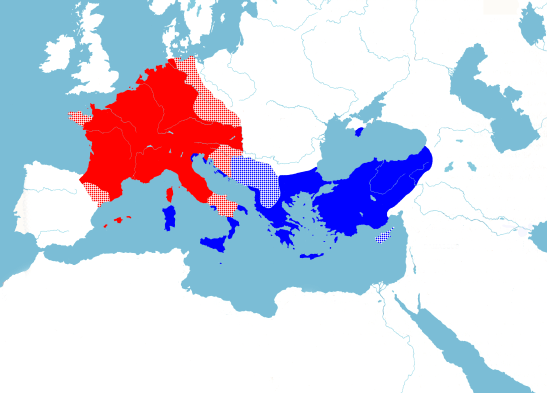
Zachary's successor Stephen cemented the Papal-Frankish alliance byconferring the title Patrician of the Romans upon Pepin in 754. In so doinghe was usurping the role of the Emperor, but the latter was in no positionto stop him. In 756 Pepin defeated the Lombard King again, and forced himto give up the last century of conquests from the Empire in northern Italy.The Emperor Constantine V demanded that the ceded territory be returnedto Byzantium, but instead Pepin gave it to the Pope, creating the PapalStates (Patrimonium Petri). In 772 Papal bulls ceased to bear theEmperor's name. In 774 Pepin's son and successor Charles the great (Charlemagne)conquered the Lombard Kingdom, calling himself King of the Franks and Lombards.The Papal States became a Frankish protectorate, and Charles went on toconquer almost the whole of continental Christian Western Europe. In 800,when Charles was visiting Rome, Pope Leo III took the logical step of anointinghim "Emperor governing the Roman Empire", reputedly to Charlie's own surprise.At first, the Byzantine Empire ignored this claim, but, under militarypressure from Charlemagne in the Adriatic and southern Italy, they recognizedhim as Emperor of the Franks in 812. They reserved the title Emperor ofthe Romans for themselves, and emphasized this point by introducing thatinscription on their coins. Nevertheless, Charlemagne was now the equalof the Byzantine Emperor, ruling over a reborn Roman Empire in the West.Meanwhile, in the East, the Byzantines had stabilized their frontier withthe Arabs and regained significant territory in the Balkans from the Slavs.
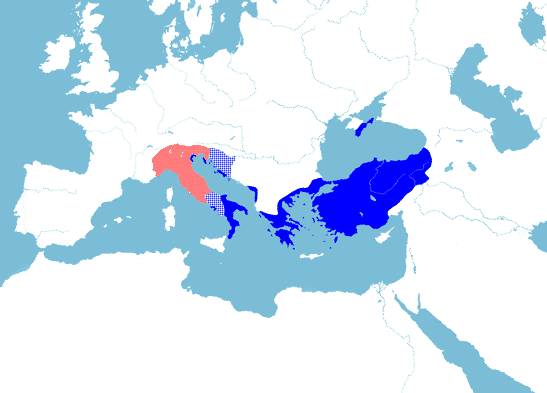
After Charlemagne's death in 814 the Western Empire began a slow processof disintegration. By 888 it was reduced to northern and centralItaly, and after 924 its rulers ceased to pretend to be Emperors, and insteadcalled themselves Kings of Italy. As the most direct successor to the WesternEmpire, this Kingdom is indicated above in pale red.Meanwhile, from 812 much of the Balkans had come under the rule of theBulgars, relatives of the Huns. They reached their peak under the KhanSymeon (893-927), who was crowned Emperor of the Bulgars by the Patriarchof Constantinople in 913. Despite failing to capture Constantinople in926, he then ludicrously added "and the Romans" to his title. Simultaneously,the Byzantines lost territory in a renewed Arab advance, this time a maritimeone. Crete was lost in 823, Cyprus in 826, Sicily from 827-902, and Sardiniaas a consequence of the loss of Sicily. But on the Italian mainland, Byzantinepower was greater than it had been for two centuries, as they alone wereable effectively to oppose the Moslem pirates.

The eighty years from 960 to 1040 saw a remarkable recovery in the fortunesof the Roman Empires. In the West most of the lands of Charlemagne's Empirewere reunited, and this time the Empire proved far longer lasting. In 952Otto I, King of Germany, had taken the Kingdom of Italy by force. In 962,the Pope crowned him Emperor in Rome, reviving the Western Empire. Theconnection between Italy and Germany was made secure by the addition ofthe Kingdom of Burgundy (south-east Gaul) in 1033. Meanwhile the EasternEmpire regained territory it had lost up to four centuries before. From960 to 976, Nicephorus II Phocas, and John I Tzimisces, first as generalsand then as Emperors, conquered Crete, Cyprus, Cilicia, much of Syria andArmenia. Most of the small states to the east, Christian and Moslem, becameByzantine protectorates. In Europe, the Bulgarian Empire was defeated in971 and its eastern half annexed to Byzantium. In 976, John Tzimisces died,and the Bulgars badly mauled the army of Basil II (976-1025) on his firstcampaign. By 986 their Empire was almost as large as it had been underSymeon 60 years before. Basil bided his time, and prepared his revenge.In almost continuous campaigning from 1000 to 1018, he utterly destroyedthe Bulgar state, and annexed it, well earning his epithet "the Bulgar-slayer".Serbia was annexed and Croatia submitted again. Venice, however, was nowfully independent. Basil's successors, the last of the Macedonian dynasty(867-1056), were weak rulers, but the Empire continued to expand despitethem. Edessa, on the far side of the Euphrates, was taken in 1032 and in1038 the conquest of Sicily was begun.

Tougher than expected Arab resistance, and civil strife at home causedthe abortion of the Sicilian expedition by 1042. Worse was to come. From1042 to 1068 a succession of weak rulers ran down the army. To save money,active units on the eastern border were disbanded, while inactive unitscloser to Constantinople (and hence more of a threat politically) weremaintained. In 1071, the last Byzantine city in Italy fell to Norman adventurers(who had been active there for a generation), and a far greater catastropheoccurred on the eastern frontier. A huge Byzantine army led by EmperorRomanus Diogenes (1068-1071), but composed largely of mercenaries, wasrouted by the Seljuk Turks at Manzikert in Armenia. Over the next two decades,Turks occupied the whole of Anatolia; the Empire could not field an armyto stop them. In desperation, Alexius I Comnenus (1081-1118) asked thePope in 1095 to help raise an army from Western Christendom. The resultwas far beyond his expectation: in 1097 the army of the First Crusade crossedfrom Constantinople to Anatolia. By 1098 it had fought its way to Syriaand Edessa. The Byzantine army accompanying it occupied as much of Anatoliaas it could, and the new Crusader states on Roman territory (as it hadbeen a generation before) promised to recognize the Emperor as their overlord.Alexius' son John II (1118-1143) made further gains in Anatolia. His grandsonManuel I (1143-1180) forced the Crusaders to keep their word (as the abovemap reflects) in 1158, and re-established the Empire's position of dominancein the Balkans in 1159. The Western Roman Empire gained Sardinia in 1046,but lost the Duchy of Spoleto (central Italy) in 1144. It also expandedeastwards into Poland, making Silesia a dependency in 1163 and annexingPomerania in 1181.

After the death of Manuel Comnenus, the Eastern Empire went into anotherrapid decline. From 1181 to 1187, Croatia was lost to the Hungarians, andSerbia and Bulgaria gained independence. The Crusaders ceased to recognizethe Emperor's suzerainty and in 1190 captured Cyprus. Relations with theWest deteriorated, and civil wars broke out. In 1203, Alexius IV Angelus,a pretender to the throne, promised great riches to the army of the fourthCrusade if they would help him gain Constantinople and the throne. Theydid, but as Emperor he found the treasury empty. The Crusaders deposedhim and in 1204 placed one of their own on the throne, bringing into beingthe Latin Empire in Constantinople. The Crusaders and Venice (which suppliedtheir transport) managed to seize the whole coast from Constantinople tosouthern Greece, the Aegean islands, and the opposite coast in north-eastAnatolia. The remaining Byzantine territory split into states contendingfor the mantle of the fallen Empire: the Empire of Nicaea in western Anatolia,the Empire of Trebizond in northern Anatolia, and the Despotate of Epiruson the Adriatic. The first of these was ultimately successful, as EmperorMichael VIII Palaeologus recaptured Constantinople from the decrepit LatinEmpire in 1262. Much of Bulgaria and Serbia was regained, but a few Crusaderstates lingered on in southern Greece. In 1282 the Emperor of Trebizondagreed to call himself Despot instead, accepting the primacy of the Emperorin Constantinople. The two remaining independent Byzantine rulers in Greecealso submitted: the Despot of Epirus in 1284 and the Sebastocrator of Thessalayin 1288. Meanwhile, the Western Empire was losing its hold over Italy.As early as 1183 the Lombard cities in northern Italy were effectivelyindependent. The Roman Empire in the West ceased to exist in 1282, whenthe Emperor Rudolph of Hapsburg recognized the Popes' declaration of independenceof the Papal States in 1278. Ruled from Rome, the Papal States are indicatedin pale red in the above map.
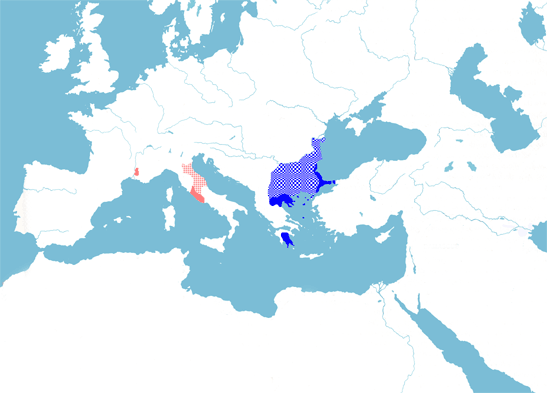
Despite all the disasters that had befallen the Roman Empire in theEast, its currency had always been the gold standard in Christendom. Butdebasement of the gold content of the hyperperon to 7 parts in 12 by 1282led the Venetians to mint their own pure gold coin, the ducate. It rapidlyreplaced the hyperperon, a symptom of the fact that the Empire was losingits trade profits to the Italian cities. With a shrinking treasury, theEmpire was unable to prevent the advance of the enemies that surroundedit: Turks, Bulgarians, Serbs, Venetians and other Westerners. Civil waragain became endemic, and then the black death struck in 1347. By thistime the Empire had lost virtually all its Anatolian lands to various Turkishemirates. One of these, the Ottomans, gained a foothold in Europe in 1354,as supporters of one faction in a civil war. By 1402 the Ottomans had conqueredalmost all of Anatolia, and much of the Balkans. The Roman Empire was reducedto Constantinople and the Morea (the southernmost part of Greece). Thefuture of the Empire seemed likely to be numbered in months, not years.Then suddenly it had a respite: the last great nomad warrior, Timur thelame, smashed the Ottoman army at Ankara. The Ottoman Sultanate fell intowarring factions, with Europe under the control of Suleyman. He restoreda few territories to the Roman Empire in order to gain the co-operationof Emperor Manuel II Palaeologus in his (unsuccessful) bid to become soleSultan. In the West, the Papal States relaxed their grip on most of theirItalian territories, during the exile of the Pope in Avignon in Francefrom 1309 to 1379.

Although Timur died in 1404, the Ottoman Empire (under one Sultan againfrom 1413) took a generation to recover its territories in Europe, andmuch longer in Anatolia. Although an Ottoman siege of Constantinople in1422 failed, they took Thessalonica (in northern Greece) in 1430. The Despotateof the Morea actually expanded, at the expense of the remaining petty Latinprincipalities, and the region saw a late flowering of Byzantine cultureand philosophy. In 1415 the Byzantines built the hexamilion, the six-milewall, across the isthmus connecting Morea to the rest of Greece. In 1444the Despot of Morea invaded Ottoman territory in conjunction with a lastcrusade from the West. In a close-fought battle at Varna the crusaderswere defeated, and the Ottomans chased the Byzantines back over the hexamilion.In 1449 Constantine XI Palaeologus, came to the throne. The last Emperorin Rome (before Charlemagne) was named after its legendary founder, Romulus,and the new Emperor in Constantinople was not only named after its founder,Constantine, but also had a mother of the same name, Helena. Many thoughtthis augured the end of the Empire, and they were soon vindicated. A newOttoman Sultan, Mehmet, came to the throne in 1451, and quickly made hisplans apparent by building a huge fortress in 1452, next to Constantinople,on what was nominally Roman territory.
The final siege of Constantinople was short, lasting from the 5th ofApril to the 29th of May 1453. Using Hungarian- designed cannon of unprecedentedsize, the Sultan blasted away at the walls built by Theodosius the greatmore than a millennium before. Constantinople was defended by just 8 000men, mostly Byzantines but with a sizeable contingent from Genoa. The Sultan'sarmy numbered perhaps ten times as many. Defeat was inevitable. Theinjured Genoese captain Giovanni Longo escaped with his men by ship justin time. Constantine went down with his city. Donning his war gear, heplunged into the final fray, never to be seen again. Thus the Roman Empirefinally ended after 1790 years.
The few remnant Byzantine states were mopped up by the Turks some yearslater: Morea in 1460 and Trebizond in 1461. But Byzantine culture continuedin the southern Balkans and on the coasts of Anatolia, where Greek-speakerscontinued to all themselves Romans (Rhomaioi) well into the 20thcentury. The Patriarch continues to reside in Constantinople, a figureheadfor Orthodox Christians in eastern Europe, the Near East, and all overthe world. Nor is the Byzantine legacy restricted to eastern cultures:the exodus of the Byzantine elite from the Morea to Italy did much to startthe Renaissance of Classical learning there. The Morea and the lands toits north was the part of Greece that first regained independence fromthe Ottomans, in 1830. The modern frontiers of Greece were not reacheduntil after the First World War, in which the Ottoman Empire came to anend . But Constantinople, now Istanbul, is still firmly in the hands ofthe Turkish state. Without it, modern Greece is inevitably to be seen asthe successor to ancient Greece, not (as it is culturally) to the lastRoman Empire.
Meanwhile, in the West, the Papacy continued to have trouble keepingcontrol ot its territory in Italy. By the mid 17th century, however, ithad regained direct control of the whole of the Patrimonium Petrias shown in the map for 1288. Recall that this territory was born as theExarchate of Ravenna in the early 7th century, the largest surviving blockof Roman territory in Italy following the Lombard invasions. Conqueredby the Lombards in the mid 8th century, it was almost immediately restoredand donated to the Pope by Pepin, King of the Franks. It continued to beruled by the Papacy, as part of a larger state until 1282, and then independently,until 1861-70 when it was annexed by the renascent Kingdom of Italy. ThisKingdom was the first unified Italian state since the Kingdom of the Ostrogoths,more than 1300 years before. For almost all of the intervening time, theband of territory linking Ravenna to Rome was a powerful factor againstItalian unity, separating Lombardy and Tuscany in the north from what becamethe Kingdom of Naples in the south. The longevity and influence of thisessentially artificial territory are almost as remarkable as those of theRoman Empire that gave birth to it.
Return to